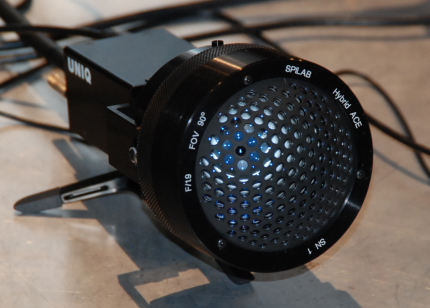AFRL working on insect-eye view for urban targeting
Lab awards additional funding for research into wide field-of-view image seekers for increased targeting ability in cluttered environments.

Spectral Imaging Laboratory’s Artificial Compound Eye hybrid camera.
Operations in urban environments—an increasingly common situation for military forces—can create trouble for imaging munitions, as walls and other obstructions interfere with the line-of-sight imaging tools necessary for accurate targeting.
The Air Force Research Laboratory is working to get around those obstacles with a biologically inspired system that combines images from multiple angles. AFRL recently awarded nearly $100,000 of additional funding for a 2013 contract to Spectral Imaging Laboratory as part of the Small Business Innovation Research/Small Business Technology Transfer to perform research in wide field-of-view (WFOV) imaging seekers.
The Phase II follow-on contract seeks to focus on sub-system technologies and the Artificial Compound Eye optical technology inspired by insects. Similar to the make-up of an insect’s eye, the ACE optical system generates images from several sub-images that pull from different fields of view to smoothly piece each image together for a single, easy-to-read picture.
"The WFOV seeker concept was originally inspired by insects such as bees which use the optic flow field to control their flight and navigate. So one of the advantages of having a WFOV seeker is the potential for GPS denied navigation," AFRL researcher Dr. Nicholas Rummelt said in a release.
This is not the first time the military has turned to nature as a model for urban aerial navigation. The Pentagon’s Fast Lightweight Autonomy program seeks small UAVs that can quickly and autonomously navigate through cluttered urban environments, emulating the flights of birds and insects to provide situational awareness at the squad level.
Similarly, the clutter in urban environments can be difficult to navigate and acquire targets. The WFOV multimode seeker system that consists of multi-waveband passive infrared imaging and semi-active lasers enables soldiers on the ground to adjust laser designators and increase probability of correct identification of targets as well as non-targets. Soldiers will now be able to more precisely designate targets with increasing confidence.
The seeker system will be moderately small, with a diameter of less than five inches in diameter and a weight of 5 pounds, and will require 50 watts of power. The system also will have significant benefits outside the military realm in search and rescue, machine vision, robotics and vehicle situational awareness safety systems.




